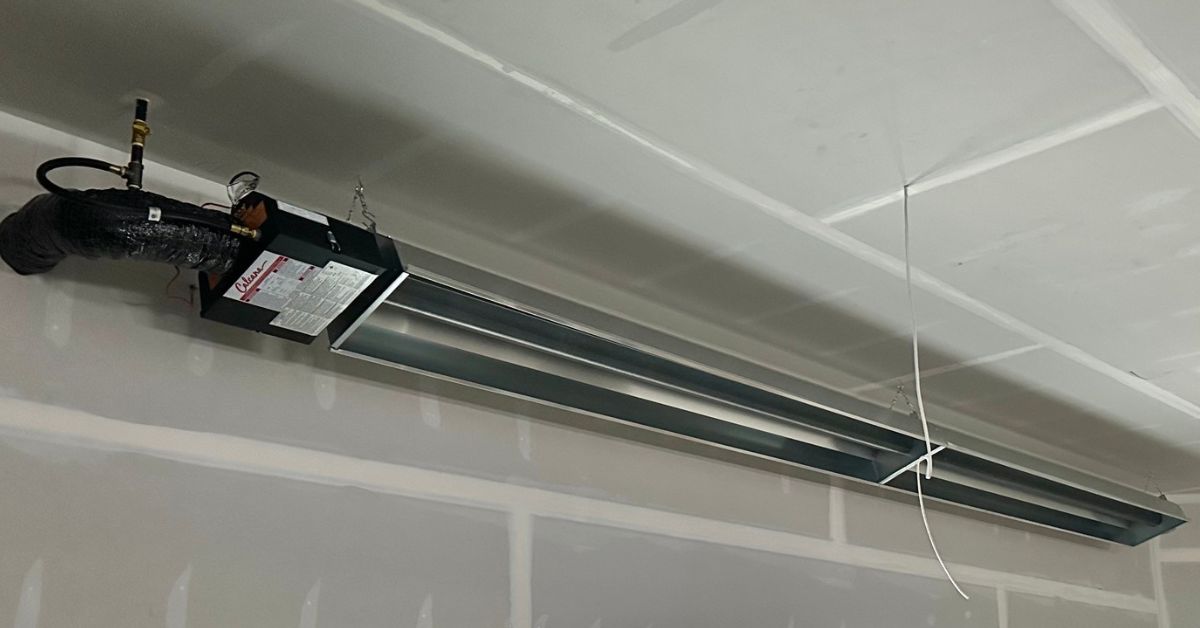Before you mount your infrared heater directly to your patio ceiling, consider measuring the vertical height of your installation. Understanding clearance requirements protects your property, prevents fire hazards, and maximizes your heater’s efficiency. As you install a new system for your business or home, determine how much clearance you’ll need on top of your infrared patio heater for reliable temperature regulation.
Why Clearance Matters for Patio Heater Safety
Adequate clearance above a patio heater allows the system to function properly and safely in your outdoor living spaces. Heat dissipation requires sufficient space to prevent dangerous heat buildup that could damage ceiling materials, wiring, or structural components. When you maintain vertical spacing, hot air can circulate freely and cool naturally before reaching overhead surfaces.
Insufficient clearance creates conditions where combustible materials can reach ignition temperatures, potentially causing property damage or personal injury. Even non-combustible ceiling materials can transfer dangerous heat to adjacent wooden beams, insulation, or electrical components hidden within the structure. To avoid further complications, measure your ceiling height or contact professional installers who can assist you with the mounting process when you need support.
Performance Optimization Through Strategic Spacing
Your patio heater operates most efficiently when clearance allows unobstructed heat distribution. Cramped installations force heated air to recirculate prematurely, which reduces the effective heating range and increases energy consumption. When you mount your unit at the appropriate height, this enables your infrared heater to project warmth across the intended coverage area without interference from overhead obstacles.
Temperature regulation also becomes more predictable when you provide adequate clearance space. The heating unit can respond accurately to thermostat settings and environmental changes in order to maintain consistent comfort levels throughout your outdoor space. This precision translates into better energy efficiency and longer equipment lifespan.

Standard Clearance Requirements for Different Heater Types
Infrared patio heaters typically require different clearance specifications based on their power output, mounting configuration, and heat distribution pattern. Most residential units demand minimum clearances from 18 to 36 inches above the heating element, while commercial-grade installations may require additional space to accommodate higher BTU outputs.
Electric infrared heaters generally need less vertical clearance than gas-powered units because they produce more controlled heat patterns. However, you should never assume that electric models won’t damage nearby materials if placed too close. Even electric units generate substantial surface temperatures that require adequate ventilation space.
Ceiling-Mounted Installation Factors
Ceiling-mounted patio heaters must accommodate both upward heat dissipation and downward heat projection. Most ceiling-mounted infrared heaters perform optimally when installed 8–10 feet above the ground surface, but this measurement must account for adequate clearance to the ceiling structure above. Factor in the heater’s housing dimensions, mounting hardware thickness, and required clearance space when calculating total ceiling height.
Measuring and Planning Your Installation Space
Accurate measurements prevent installation mistakes and comply with business or residential safety standards. Start by measuring the total vertical space available, from the desired mounting height to the ceiling above. Account for ceiling fans, light fixtures, or architectural features that might interfere with clearance.
When analyzing these numbers, consider seasonal changes that might affect your clearance calculations. Thermal expansion of ceiling materials, settling of new construction, or modifications to overhead structures could reduce clearance over time. Including an additional safety margin protects your installation against these variables.
Tools and Techniques for Precise Measurement
If you choose to schedule a professional installation, these specialists use laser measuring devices and digital levels for accurate clearance calculations. These tools eliminate guesswork and provide documentation for warranty and inspection purposes. Using tape measures and traditional levels can help you achieve acceptable results for most residential installations.
Mark your proposed heater location clearly, and measure clearance from multiple points around the mounting area. Ceiling surfaces may not be perfectly level, so identifying the minimum clearance point prevents uneven mounting during installation. For your convenience, take photographs of your measurements to reference during the process.
Local Building Codes and Compliance Requirements
Building codes vary between jurisdictions, and many municipalities have requirements for outdoor heating appliance installations. Check your local regulations before beginning installation to determine how much clearance you need on top of your patio heater.
Some areas require professional inspections of patio heater installations, particularly for commercial properties. Homeowner associations, for instance, may impose additional restrictions beyond municipal building codes. Review your property’s governing documents and consult relevant authorities before finalizing your installation plans.

Maintenance and Long-Term Clearance Management
Regularly inspecting clearance prevents gradual encroachment that could compromise safety or performance. Vegetation growth, storage of seasonal items, or extra overhead features can reduce effective clearance over time. As an easy solution to these potential hazards, schedule annual clearance verification as part of your routine heater maintenance.
Cleaning debris from clearance areas maintains air circulation and prevents fire hazards. Leaves, spider webs, and lint can accumulate in overhead spaces and create combustion risks when exposed to heat. It’s best to clear out all combustible materials throughout the heating season.
Seasonal Preparation and Storage
Outdoor heaters face exposure to weather conditions that can affect clearance requirements over time. Wind-blown debris may accumulate above the heater, and ice formation could temporarily reduce clearance in cold climates. Inspect and clear these areas before each heating season begins.
Protective covers for your heater prevent debris accumulation while maintaining clearance during storage periods. Check that the covers fit properly without compressing clearance spaces or creating new obstruction concerns.
Troubleshooting Common Clearance Issues
Ceiling infrared heaters warm outdoor spaces quickly; does your patio ceiling provide enough clearance? When vertical space limitations prevent your setup from meeting clearance requirements, consider alternative mounting locations, different heater models with reduced clearance needs, or structural modifications to increase available space.
Sloped ceilings create irregular clearance measurements that require careful planning to maintain minimum requirements across the entire heater footprint. Document clearance measurements at multiple points, and use the smallest measurement as your working clearance value.
Alternatively, wall-mounted heaters may offer solutions when ceiling clearance proves inadequate. These units project heat horizontally rather than vertically, reducing overhead space requirements while maintaining effective coverage patterns. Evaluate whether wall mounting provides suitable heat distribution for your specific application.
Using the right hardware will achieve a sturdy and compliant patio heater installation. For the best results, partner with our specialists at Calcana USA to find the best products for your commercial or residential property. Invest in easy-to-install infrared heater wall mounting kits at Calcana USA, and start regulating the temperatures in your outdoor living spaces today!




Leave a comment
This site is protected by hCaptcha and the hCaptcha Privacy Policy and Terms of Service apply.